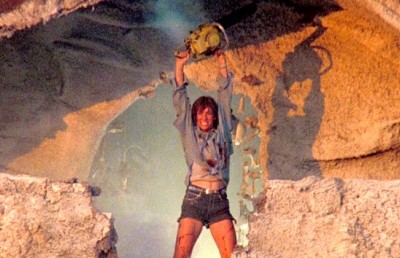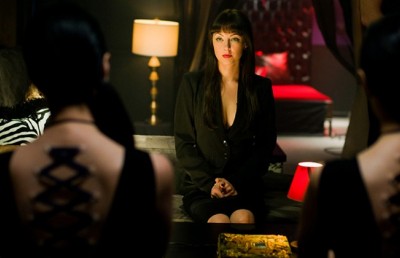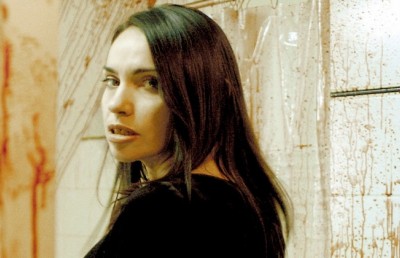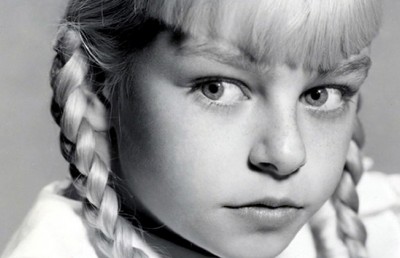Fille Finale: The Final Girl in New French Extremity
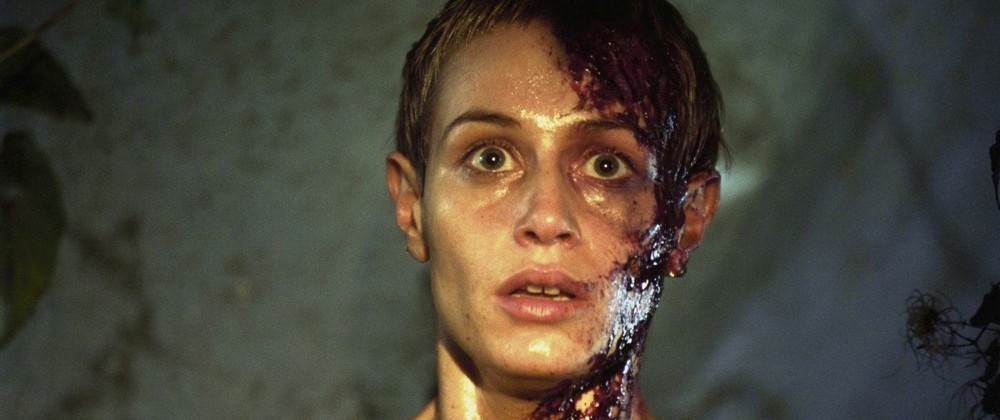
When Artforum critic James Quandt coined the term New French Extremity in 2004, he was referring to a series of violent horror films that had emerged from France in the new millennium which helped define a movement of films that were capturing and horrifying audiences’ imagination. These films possessed shocking violence and emotional brutality but were tempered with philosophical themes and discussion, making them hard to discount within the discussion and analysis of genre films. While France has always had a history of graphic depictions of violence, there seemed to be something affronting about this new set of films. After the atrocities of September 11th, weren’t we all supposed to play a bit nicer?
Three of the most popular films to emerge from the New French Extremity movement are arguably Alexandre Aja’s High Tension (aka Switchblade Romance ) (2003), Alexandre Bustillo and Julien Maury’s Inside (2007) and Pascal Laugier’s Martyrs (2008). Each of these films has (in the minds of critics at least) pushed the boundaries of good taste and excess and each of the these films have made an impact in the all important North American market while impressing genre fans across the world. While on the surface these films are quite different in terms of content but comparable in aesthetics, they all perform a similar act of subverting and perverting our notions of the slasher film. These films attack Western society’s closest held constructs of civility and sanity. By critiquing the constructs of religion, family and sexuality, respectively these films show that within a society filled with comforts and distractions, sooner or later we’re all bound to go a little mad.
The closest relatives these films have are the chaotic prototype slashers of the early 1970s, such as Wes Craven’s Last House on the Left (1972) and Tobe Hooper’s The Texas Chain Saw Massacre (1974), which saw two very different families slice and dice a group of outsiders for two very different reasons. The films, while horror classics, also mirror the hysteria that America was experiencing at that time with the Vietnam War. While the films of New French Extremity are far slicker and more refined than their predecessors, the films adapt the mould to the slasher film in the beginning then subvert the audience’s expectation through use of gender and transference.
In Carol Clover’s seminal work Men, Women and Chainsaws (1992) she identified and defined the notion of the Final Girl. This character was the hero of the slasher genre; a young woman who was relatively pure in comparison to her friends, the would-be victims, she is the sole survivor and eventually fights and defeats the monster. Clover’s work discussed the pattern of gender transference that separates her from the other characters. She is weary and watchful, but more importantly not sexually active and bears typically masculine qualities. This helps her fight the monster and then at the end of the film, when normalcy is restored, the Final Girl returns to a feminized character with the arrival of patriarchal male characters such as doctors or the army. New French Extremity works within these genre constraints until the final act. In each of these films, the power structure does not revert to normalcy. The Final Girl is subverted in some way; the good are punished and the monster is a part of their lives.
Since the 1990s, France has been a hotbed of political upheaval and controversy in the European union. Multiculturalism and the “melting-pot” metaphor became realities for first world countries as immigrants settled in new countries, had families and became a part of communities. The new identity of France was a confused one. While Paris was still an international centre for culture, the mid-90s saw multiple terrorist attacks on the city by Islamic terrorists. In 1995 the Armed Islamic Group launched five separate attacks on the Paris Metro in an effort to bring the fear and violence of the Algerian Civil War to France. Into the new millennium, politics were at the heart of civil unrest. While President after President claimed to have the solution for unemployment in France, little progress was made. The civil unrest came to a head in 2005 and 2007 with wide-spread riots, which resulted in France declaring a state of emergency. While many reasons have been attributed to the start of the riots, they brought to light the vast differences in wealth, culture and political ideology within the county. For a nation that fought to overthrow Kings and Queens, new unrest was brewing within.[[“Bomb explodes on Paris Subway.” CNN World News_. Oct. 1995. Online article available at http://edition.cnn.com/WORLD/9510/paris_bomb/10-17/
One of the most challenging artistic theories to be put forth in the twentieth century was courtesy of theatre practitioner Antonin Artaud who wrote his treatises on theatre entitled The Theatre & Its Double . In its shortest but most influential section, Artaud discusses the Theatre of Cruelty. In this theory Artaud posits that the cruelty comes from actors playing out truths for the audiences. “Everything that acts is a cruelty. It is upon this idea of extreme action, pushed beyond all limits, that theatre must be rebuilt” (Artaud 89). Through this theory Artaud sought to free humanity from its restraints of social conformity and return his audience to a more primal and truthful state. What we see in the New French Extremity movement is the filmmakers taking on the mantle of the slasher film (in all its forms) and reassembling it to reflect the troubling changes in the notion of the self that have become prevalent in the last two decades. In all three films the protagonist is deeply troubled in some way and when an outside force attacks, the audience’s sympathies lie with the our hero. When the attacking element is revealed to be part of the protagonist’s mental and physical state the audience members’ loyalties may not of been misguided, but they have been purposefully misdirected. The films of New French Extremity expose the audience’s expectations of the genre and by subverting them create a new bleak reality where there are no true heroes or villains, only an uncertain future.
Alexandre Aja’s 2003 film, High Tension has become one of the most influential horror films of the last decade and continues to divide fans based on its infamous final twist. The film follows Marie (Cécile De France) a college student driving up with her friend Alex (Maïwenn) to Alex’s family’s country house for a weekend of quiet studying. Once there, Marie is introduced to Alex’s family, given a quick tour and settles in for the night. While this very ordinary set up is happening, the film intercuts with the introduction of a character only credited as Le Tueur, or “Killer” in English (Phillipe Nahon); we meet him as he has a severed head perform oral sex on him. This is intercut with Marie masturbating while thinking about Alex, it is at this point that chaos descends on the quiet home. The doorbell is rung and when Alex’s father goes to answer it, he is brutally slaughtered and at that point the film turns into a nightmarish world of death and destruction. Le Tueur stalks and kills Alex’s family, captures Alex, ties her up and transports her in a van. Throughout all this Marie avoids detection as she simultaneously hides and follows Le Tueur and Alex in hopes of saving her and perhaps bringing herself and Alex together. In the film’s climax it is revealed that the Le Tueur and Marie are the same person and that Marie has killed Alex’s family in hopes of never being separated from Alex again.
High Tension has been read through a variety of lenses that all lead to the conclusion that Marie’s personality splits as she is about to climax while thinking of Alex and pleasuring herself. Unable to cope with homoerotic desires, she manifests a hulking male figure to carry out her secret desires of destroying everything and everyone that could possibly keep her and Alex apart. “The violence of the schizophrenic woman does not only nourish male anxiety, but also female anxiety of a sexual threat. The frightening male representation of her lesbian desire and the related phallic aggression turn Marie into an impure and interstitial perpetrator with confused gender aspects. Consequently, her fury affects men and women alike; the terror works in both directions” (Hurst 109). The psychotic fantasy is stopped when Alex escapes her confines and makes a run for it. The audience now clearly understands that Marie has been both the Final Girl and Monster, but Marie never experiences transference; the spell is never broken. It is Alex who transfers from victim to Final Girl, breaking the aforementioned spell by violently stabbing Marie, not to release Marie, but to end the madness.
The film ends with Marie institutionalized and eerily reaching out towards Alex who is not visible to her through a one-way mirror. Through this ending we understand that balance has not been restored. For Carol Clover who clearly identified and analyzed the tropes of the slasher film, the final moments of the slasher film are all important to the societal and cultural conclusions of the film: “The last moment of the Final Girl sequence is finally a footnote to what went before, to the quality of the Final Girl’s fight, and more generally to the qualities of character that enable her, of all the characters, to survive what has come to seem unsurvivable.” (Clover 40)
Marie and Alex’s worlds have both been irrecoverably altered. Alex, in that she has lost her family, and Marie, in that she has completely broken with reality. In previous incarnations of the slasher, Marie would have subdued Le Tueur, possibly saved Alex and been able to revert to her previous feminine state. This lack of cohesion to previously understood tropes of the genre makes it harder to read. The chaotic nature of the film mixed with the completely illogical ending of the film renders it as only understandable through complete subjectivity. In order to make sense of the film, we must try to understand a schizophrenic mind because, logically, the events of the film could not have occurred in the way the audience sees them. As film critic Roger Ebert pointed out in his review “clever viewers will be able to see for themselves that the movie’s plot has a hole that is not only large enough to drive a truck through, but in fact does have a truck driven right through it.” So, we must understand the madness through Marie’s diseased mind and seek some reprisal of sanity through Alex’s Final Girl conclusion. Although, through the transference of the role of Final Girl to Alex we lack resolve for Marie’s character who manages to survive but has not forgotten Alex. We understand that the nightmare of the film has not ended. While the (archetypal?) monster may continue on in other iterations of the slasher film, it is a rare film indeed that shows us that the monster was our guide through the film, cloaked our understanding of the world of the film and eventually triumphed through survival and rejection of the world order.
Alexandre Bustillo and Julien Maury’s film Inside (2007) grapples with a nightmarish home invasion on Christmas Eve. Sarah (Alysson Paradis) settles in for a quiet night before the birth of her child. Guarded and unsure, we learn that her husband died in a car crash that occurred when she was driving. Now alone, she waits until morning when she will be admitted to the hospital to give birth. Shortly after dozing off, a woman known as La Femme (Béatrice Dalle) arrives at her home and knows a great deal more about Sarah than she should. La Femme breaks into the home attacking Sarah and anyone else who stops by. After the resulting blood-bath, we learn that La Femme was driving the other car in the accident. Though Sarah was told that nobody but herself survived the accident, La Femme reveals that she survived but the child she was carrying did not. Subsequently, La Femme seeks to obtain Sarah’s child to replace the one she lost. After enduring several brutal attacks Sarah goes into labour and La Femme performs a caesarean section to help deliver the baby. In the final images of the film Sarah lays dead covered in blood and La Femme, who has also sustained horrific attacks and is severely wounded, sits in a chair quietly rocking the newborn in her arms.
Inside is a visceral movie. While the special effects are prominent within it, the performances throughout the movie are uniformly strong and the story at its centre is designed to give the audience a sense of emotional confusion. We again relate to Sarah as our Final Girl; she is the protagonist and the one with something to lose. La Femme is the antagonist who brings violence and upsets the world order of the film, but as far as protagonists go, Sarah is about as cold and distant as you can get. She seems irritated by her mother wanting to help and by her boss/romantic interest’s concern. The audience wonders what kind of mother Sarah will be because she seems dead already. By contrast, La Femme is a psychopath; at least she is a maternal psychopath who desperately wants the child. While she attacks Sarah, she will not let the child within her come to harm.
During the film, police officers enter the house to check on Sarah who called them earlier in the film. La Femme dispenses with all of them except one officer who she shoots with his riot gun. When he gets up he is badly injured and he has also suffered brain damaged due to the injury. Mistaking Sarah for La Femme he attacks her. La Femme, not wanting the child to be harmed, comes to her defense and kills the officer. Here we see the transference of the La Femme becoming the Final Girl; she is the one who changes and is able to adapt to the terrifying situation, albeit one that La Femme has brought about herself. As seen in High Tension ,the transfer of victim to hero is not incurred by the final fight with monster; it is achieved by another character stepping in and assuming the Final Girl mantle. While we feel for Sarah viscerally as she endures attack after attack, we do not identify with her. She is too distant and withdrawn. La Femme, however, does elicit the audience’s sympathies as a hysterical mother, lost without a child.
A common theme in horror films is that of parenthood and responsibility, and there can be no parent that does not feel the weight of responsibility for caring for their child. While La Femme carries on disrupting the world and natural order she is ultimately allowed to triumph and in doing so, subverting our expectations of not only the genre but of a mother’s love. We see a selfish woman allowed to carry a child to term, while the passionate (albeit emotionally unstable) mother must fight for her right to a child.
Cultural critic and professor Barbara Creed wrote about the relationship of mother and child through the theory of the abject in horror films: “We can see abjection at work in the horror text where the child struggles to break away from the mother, representative of the archaic maternal figure, in a context which the father is invariably absent (Psycho, Carrie, The Birds). In these films the maternal figure is constructed as the monstrous feminine. By refusing to relinquish her hold on her child, she prevents it from taking its proper place…” (Creed 42) In Inside Bustillo and Maury create a world where the mother is seemingly rejecting the child before it is born. They show us what could possibly be one of the most unnatural images the mind could conjure up, that of a mother rejecting a child. To rectify this, it is the monster who accepts the child and emotionally, though not structurally, becomes the rightful protagonist of the film.
Pascal Laugier’s Martyrs (2008) is possibly the most nightmarish film in contemporary horror cinema. It attacks its viewers on almost every front. It is a horrifically fascinating look at religious extremism, social bonds and the right to knowledge. The film begins with a young girl named Lucie escaping from a warehouse where she was being tortured. She is then put in an orphanage where she befriends another young girl named Anna. As Anna helps put Lucie at ease she discovers that Lucie is tormented by a disfigured woman. Fifteen years later Lucie bursts into a seemingly normal family’s home killing them all. Anna arrives on the scene but it is too late. The two try to clean up and escape. Lucie, however, is still being viciously attacked by the disfigured woman (who is revealed to be a product of Lucie’s tortured psyche), and realizing she will never escape her tormentors, Lucie kills herself. While mourning for her friend, Anna discovers a secret lair in the house used for torture. A secret society arrives and informs her that they are trying to learn the secrets of the afterlife by attempting to create martyrs and that Lucie was an early failed experiment. They have never successfully created a martyr, only victims. Anna is then taken by them and tortured. Lucie appears to her in a dream and tells her to “let go.” Anna does and in doing so, goes further than any other torture victim. She is then flayed alive and achieves transcendence. When the head of this organization, Mademoiselle, arrives to find out what she has learned Anna whispers in her ear. When one of the followers asks what she said, Mademoiselle kills herself saying, “keep doubting.”
Though the above synopsis may not make it obvious, the film is very much about life and being able to live your own. In a first world culture which has the opportunity to be wealthy enough to worry about the afterlife, a secret society has come together murdering woman after woman in hopes of validating the society’s existence. They kill in order to give themselves a reason to live on.
While the film opens with Lucie as a young girl in the flashback, she is a young woman when she enters the family’s house. As Lucie relives her past traumas, which she has never truly escaped, she crumbles beneath the weight of what she has had to bear and takes her own life. The film is her journey, one that she starts but is unable to finish. In this case, the monsters are the secret society and they managed to create another victim. Anna is a motherly figure from the outset, taking care of Lucie and supporting her when they are children as well as when they are adults. Her inability to leave her friend is ultimately what lets her fall into the hands of the secret society, but also what allows her to free herself from the torture they inflict on her. Lucie, though we root for her to be the Final Girl and overcome the atrocities inflicted on her, is unable to do so and even after escaping the monsters, she still falls victim to them.
Interestingly, Clover identified the victims in slashers as being punished for their sexual transgression: “Boys die, in short, not because they are boys but because they make mistakes. Some girls die for the same mistakes. Others, however, and always the main one [victim] — plot after plot develops the motive — because they are female.” (Clover 37) The Mademoiselle tells Anna that they test on young women because they are more sensitive and susceptible.
Lucie could not survive because the torture stripped her of those traits, but because of Anna’s social and innate adherence to them she survived, in a sense at least. As the audience transfers their allegiance to Anna, she is almost immediately tortured and we witness her on the receiving end of the cruelest treatment imaginable. The Final Girl in Martyrs does not escape, she succumbs. Even the ending wherein the Mademoiselle kills herself leaves the audience curious as to what this secret organization has learned about from the torture and murder of innocent people. The title card that appears at the end of the film tells us that Martyrs comes from the Greek word meaning “to witness”. Just as Anna witnessed what exists beyond this existence (we assume), we the audience are witness to her torture and the destruction of her humanity carried out for the purpose of serving others. As Clover concludes in her section about Final Girls, the modern slasher is essentially “a hero plot, revolving around the main character’s struggle with and eventual triumph over evil. But for the femaleness, however qualified, of that main character, the story is a standard one of tale and epic.” (Clover 45) Laugier presents this with both a masculinized Final Girl in Lucie and a feminized one in Anna. While Anna survives on some level, her revelation and her heroic journey are not her own; it is for the monster, and even the monster can’t handle the truth.
People across the globe are questioning the notion of the self and identity with the rise of multiculturalism in a fast-paced information age. New French Extremity, however, takes from the notions of French artists and theorists before them and does not simply question the world, but rips it apart. High Tension , Inside and Martyrs all reveal the thin layer of artifice which allows the constructs of sexuality, family and religion to exist. By introducing an unexpected element of chaos (Marie in High Tension , La Femme in Inside and Anna in Martyrs ) we see how quickly the illusion disintegrates before us. New French Extremity cleverly utilizes the initial tropes of the slasher genre to situate the audience in something familiar, but just as quickly rips the rug out from underneath us. These bold and shocking films have raised the ante for horror films across the world, but few have been able or brave enough to fully subvert the tropes as these films have to show us the bleak world that exists just beyond the curtain of artifice.
By disallowing the Final Girl’s transference, which would complete her role in the modern slasher formula, the worlds of these films rupture. The role of protagonist is transferred to another character and they help take the films to an entirely new place. Alex brings the world of High Tension back to heterosexual “normality” but that does not mean Marie is not still obsessed with her. La Femme ensures the child’s safe delivery and means to care for the child but in the process kills its mother. Anna’s empathic and motherly nature makes her the candidate this secret society has been waiting for but reveals something that makes them question everything. These women who take up the title of Final Girl now carry on in a strange new world; they are a new breed of heroine in a world where surviving does not mean a happy ending. The question is now that society’s constructs have been shattered and nothing is certain, will they want to?
Works Cited
Artaud, Antonin. Theatre and Its Double . Trans. Mary Caroline Richards. New York: Grove Press, 1958.
Clover, Carol J. Men, Women and Chainsaws . Princeton New Jersey: Princeton UP, 1992.
Creed, Barbara. “Horror and the Monsterous-Feminine: An Imaginary Abjection.” The Dread of the Different: Gender and the Horror Film . Ed. Barry Keith Grant. Austin: University of Texas, 1999.
Hurst, Matthias. “Subjectivity Unleashed: Haute Tension.” European Nightmares – Horror Cinema in Europe Since 1945 . Ed. Patricia Allmer, Emily Brick & David Huxley. New York: Wallflower Press, 2012.
Quandt, J., 2004, Flesh & Blood. Sex and Violence in Recent French Cinema . Artforum, Feb. 2004. Online article available at http://www.artforum.com/inprint/id=6199



